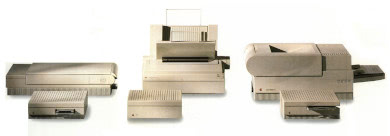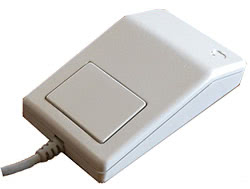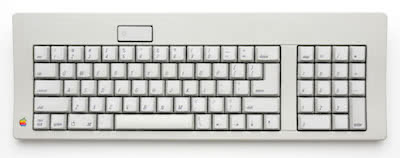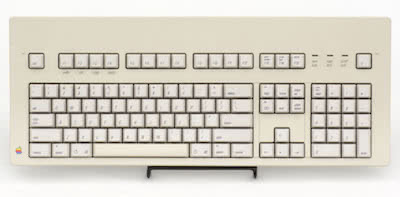SE/30 Forever
< Back to homePeripherals

Above: By 1990, Apple had a formiddable product line-up of peripherals including printers, a scanner, hard drives, and tape backup drives, all following Apple's Snow White design language and ease of use patterns, making them excellent accompaniments to a Macintosh SE/30.
Peripherals could be attached to the Macintosh SE/30 via ADB (Apple Desktop Bus), SCSI or Serial. Different devices tended to use different ports. Keyboards, mouse, trackballs, graphics tablets tended to use ADB. Printers would use serial. Hard drives and other higher power devices would use SCSI. Between these three ports, the SE/30 could support many external devices such as hard drives, tape drives, scanners, printers and more. A SCSI chain of devices can contain up to 7 devices, and ADB devices can also be daisy chained.
Apple Desktop Bus Mouse (G5431/A9M0331)

Above: Apple Mouse G5431, source: raneko (Flickr)
Every Macintosh SE/30 shipped with an Apple Mouse, specifically the G5431/A9M0331 model which uses the Apple Desktop Bus (ADB) standard. This mouse was produced from 1986 and originally shipped with the Macintosh SE and Macintosh II. The mouse has a square shape with a satisfying feel and click from the Omron microswitch. This was the first ADB-based mouse that Apple produced. There were slight variations on the design through the years, the top remained the same but the bottom design changed a few times. The color of the G5431 mouse is the same as the SE/30's platinum off-white color. Most of these mice were produced in Cork, Ireland using parts from Logitech. This mouse stayed true to Apple's history of only using a single mouse button, other computers (IBM PC clones, Amigas, etc) at the time typically used a two or three button mouse.
Optional extras
Available separately to the SE/30 were two choices of keyboard from Apple, the Apple Keyboard (M0116) or the Apple Extended Keyboard (M0115). Apple did not bundle a keyboard with the SE/30 so that a buyer could choose which keyboard they wanted, at additional cost.

Above: Text from Apple's SE/30 brochure
Apple Keyboard (M0116)

Above: Apple Keyboard M0116, source: baku13
Also known as the Apple Standard Keyboard, to differentiate it from later models, this was introduced with the Macintosh SE and II in 1987. It was available for $129. This keyboard uses parts from Alps Electric.
The Apple Standard Keyboard features two bidirectional ADB ports that function either as upstream (to connect to the computer or another ADB device higher up the chain) or downstream (for connecting the mouse or downstream peripherals). The cable is detachable and connects to either ADB port, with the mouse normally connected to the other port. Right-handed people would typically use the right-hand ADB port for the mouse, and left-handed people would use the port on the left; the other port is used for the keyboard cable.
Normal keys use either Alps SKCM Orange or Salmon switches. The caps lock key uses an Alps SKCL Lock switch.
The keycaps are dye sublimated PBT (except the space bar, which is ABS), and have Apple's typical bottom-left legends with italic type, in the font Univers Condensed Thin.
Most of these keyboards were assembled in Cork, Ireland.
More photos and information about the Standard keyboard.Apple Extended Keyboard (M0115)

Above: Apple Extended Keyboard (M0115), source: Kevin Schoedel
The Extended keyboard was introduced with the Macintosh II and Macintosh SE, which did not come with a keyboard. Instead, buyers had the option of buying an Apple Standard Keyboard or the more expensive Extended keyboard with more keys. This is the first "full-size" keyboard from Apple, with inverted-T arrow keys and navigation cluster. It was succeeded by the Apple Extended Keyboard II in 1990.
Normal keys have either Alps SKCM Orange and Alps SKCM Salmon switches. The caps lock key has an Alps SKCL Lock switch. Like the other Apple keyboards from the same era, the keycaps are in Apple's special profile and with dye sublimated legends in italic type. There are bidirectional ADB ports under the top left and right corners of the keyboard.
Construction appears to be ABS for the case and space bar, and PBT for the remaining keycaps.
The Extended keyboard cost $229. It shipped in a white cardbox box with rainbow Apple logo.
More photos and information about the Apple Extended Keyboard